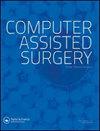单髁膝关节置换术植入物前后位x线片内翻/外翻角度估计的准确性
IF 1.5
4区 医学
Q3 SURGERY
引用次数: 0
摘要
单髁膝关节置换术(UKR)是一种减轻疼痛和改善膝关节功能的骨科手术。长期负重前后位(AP) x线片通常用于术后测量腿部对齐和评估内翻/外翻植入物的方向。然而,假体的面外旋转、使用者的可变性和x射线采集参数会在假体内翻/外翻估计中引入误差。以前的工作已经探索了这种估计中各种成像方式的准确性。在这项工作中,我们探讨了面外旋转和x射线采集参数对种植体内翻/外翻角度估计的影响。在我们的研究中,我们使用了单次CT扫描,并在CT体积内以不同的方向定位股骨和胫骨植入物。然后,使用定制的软件应用程序从不同方向的植入物CT扫描中获得数字重建的x线照片。然后要求两名使用者手动估计植入物的内翻/外翻角度。我们发现两个用户的内翻/外翻估计值存在显著的用户间差异(p < 0.05)。然而,使用实际种植体方向获得的“理想”测量结果显示,由于种植体方向的变化,误差很小。我们还发现,投影中心的变化对种植体内翻/外翻角度的估计没有统计学上显著的影响(p < 0.01)。我们的结论是人工估计UKR内翻/外翻方向是不可靠的。本文章由计算机程序翻译,如有差异,请以英文原文为准。
Accuracy of estimating Unicondylar Knee Replacement implant varus/valgus angles from antero-posterior radiographs
Abstract Unicondylar Knee Replacement (UKR) is an orthopedic surgical procedure to reduce pain and improve function in the knee. Load-bearing long-standing antero-posterior (AP) radiographs are typically used postoperatively to measure the leg alignment and assess the varus/valgus implant orientation. However, implant out-of-plane rotations, user variability, and X-ray acquisition parameters introduce errors in the estimation of the implant varus/valgus estimation. Previous work has explored the accuracy of various imaging modalities in this estimation. In this work, we explored the impact of out-of-plane rotations and X-ray acquisition parameters on the estimation of implant component varus/valgus angles. For our study, we used a single CT scan and positioned femoral and tibial implants under varying orientations within the CT volume. Then, a custom software application was used to obtain digitally reconstructed radiographs from the CT scan with implants under varying orientations. Two users were then asked to manually estimate the varus/valgus angles for the implants. We found that there was significant inter-user variability (p < 0.05) in the varus/valgus estimates for the two users. However, the ‘ideal’ measurements, obtained using actual implant orientations, showed small errors due to variations in implant orientation. We also found that variation in the projection center does not have a statistically significant impact (p < 0.01) on the estimation of implant varus/valgus angles. We conclude that manual estimates of UKR implant varus/valgus orientations are unreliable.
求助全文
通过发布文献求助,成功后即可免费获取论文全文。
去求助
来源期刊

Computer Assisted Surgery
Medicine-Surgery
CiteScore
2.30
自引率
0.00%
发文量
13
审稿时长
10 weeks
期刊介绍:
omputer Assisted Surgery aims to improve patient care by advancing the utilization of computers during treatment; to evaluate the benefits and risks associated with the integration of advanced digital technologies into surgical practice; to disseminate clinical and basic research relevant to stereotactic surgery, minimal access surgery, endoscopy, and surgical robotics; to encourage interdisciplinary collaboration between engineers and physicians in developing new concepts and applications; to educate clinicians about the principles and techniques of computer assisted surgery and therapeutics; and to serve the international scientific community as a medium for the transfer of new information relating to theory, research, and practice in biomedical imaging and the surgical specialties.
The scope of Computer Assisted Surgery encompasses all fields within surgery, as well as biomedical imaging and instrumentation, and digital technology employed as an adjunct to imaging in diagnosis, therapeutics, and surgery. Topics featured include frameless as well as conventional stereotactic procedures, surgery guided by intraoperative ultrasound or magnetic resonance imaging, image guided focused irradiation, robotic surgery, and any therapeutic interventions performed with the use of digital imaging technology.
 求助内容:
求助内容: 应助结果提醒方式:
应助结果提醒方式:


